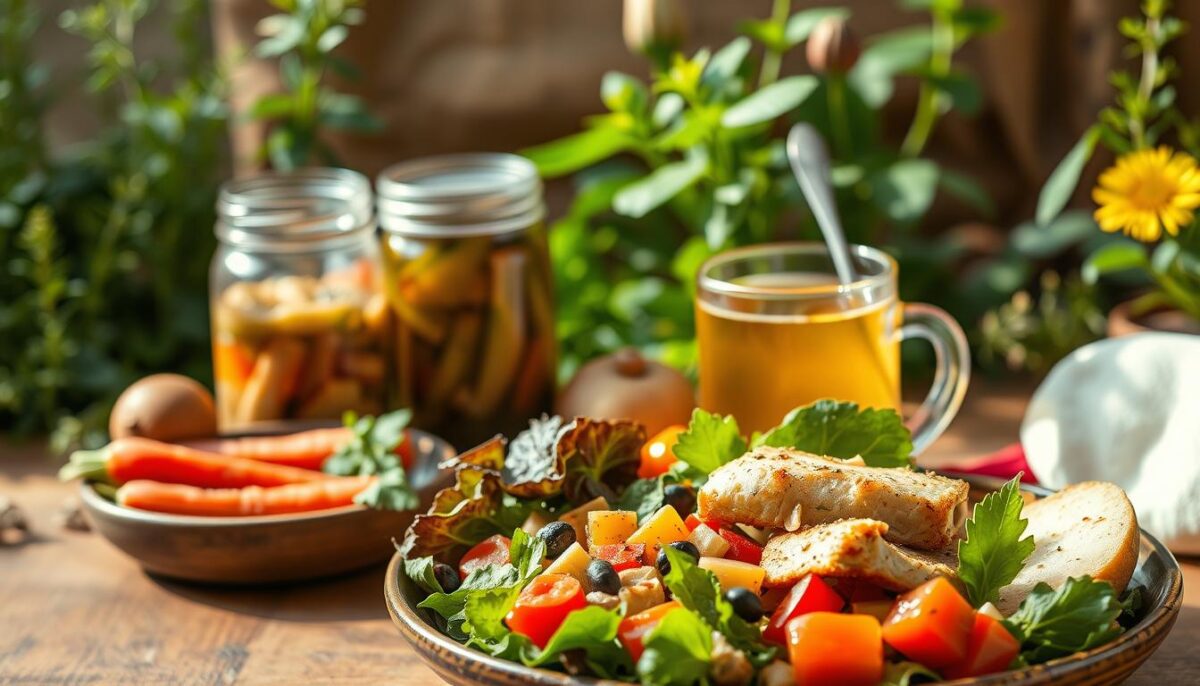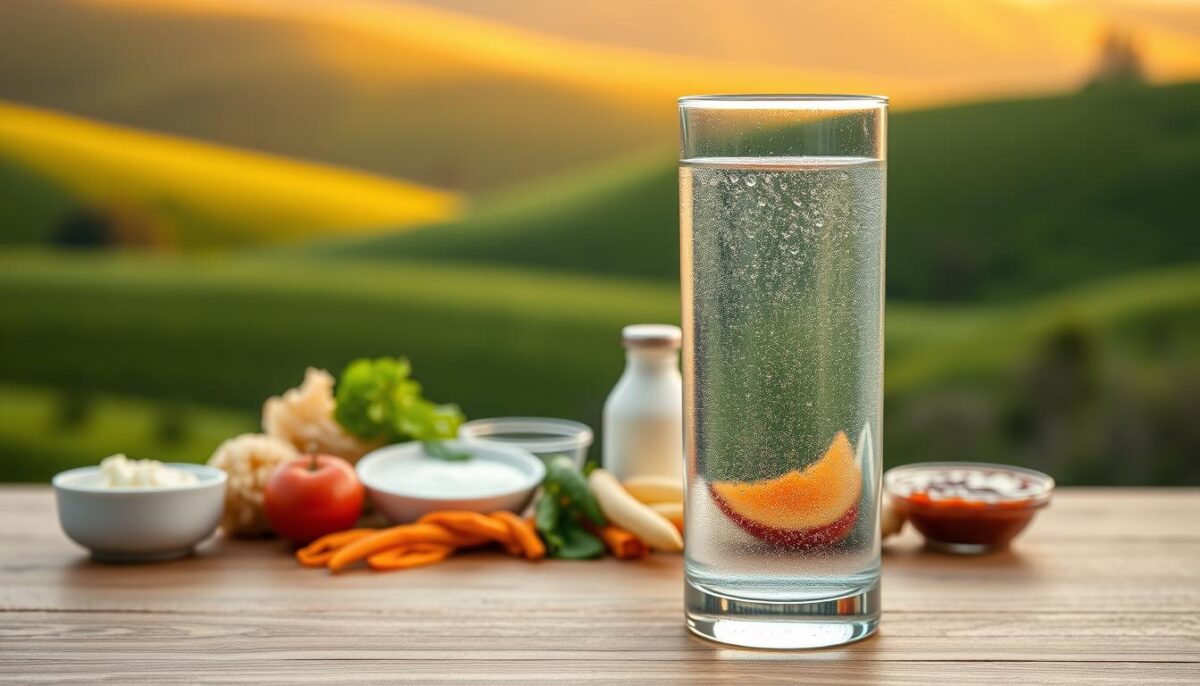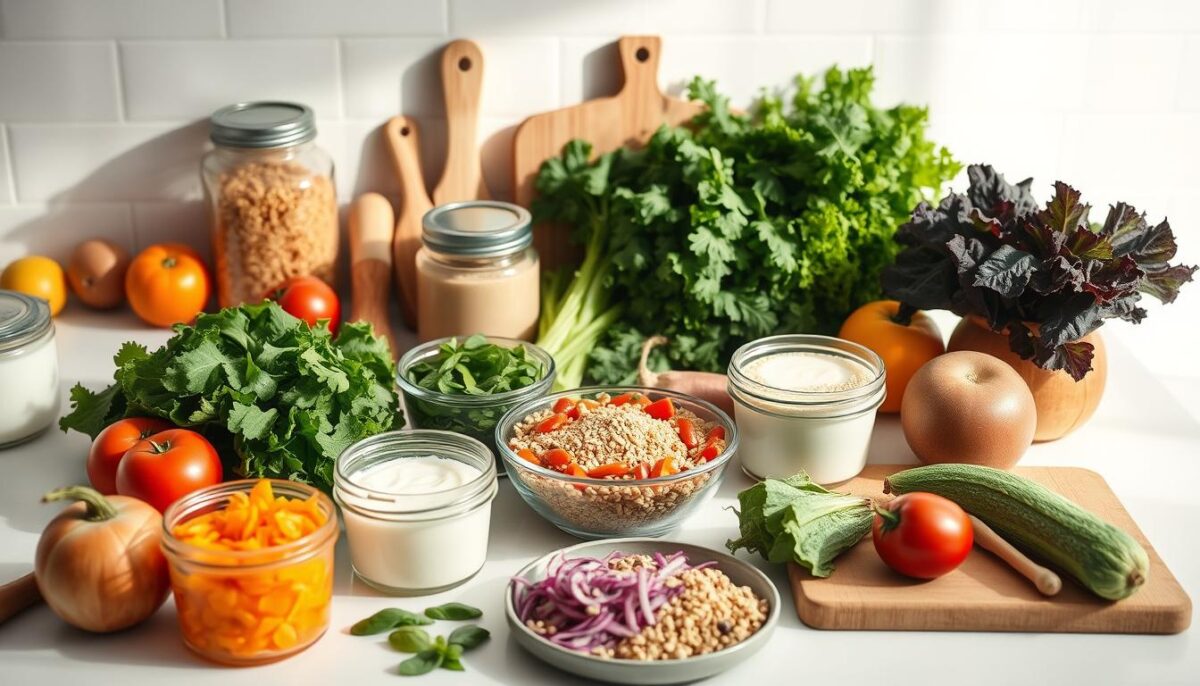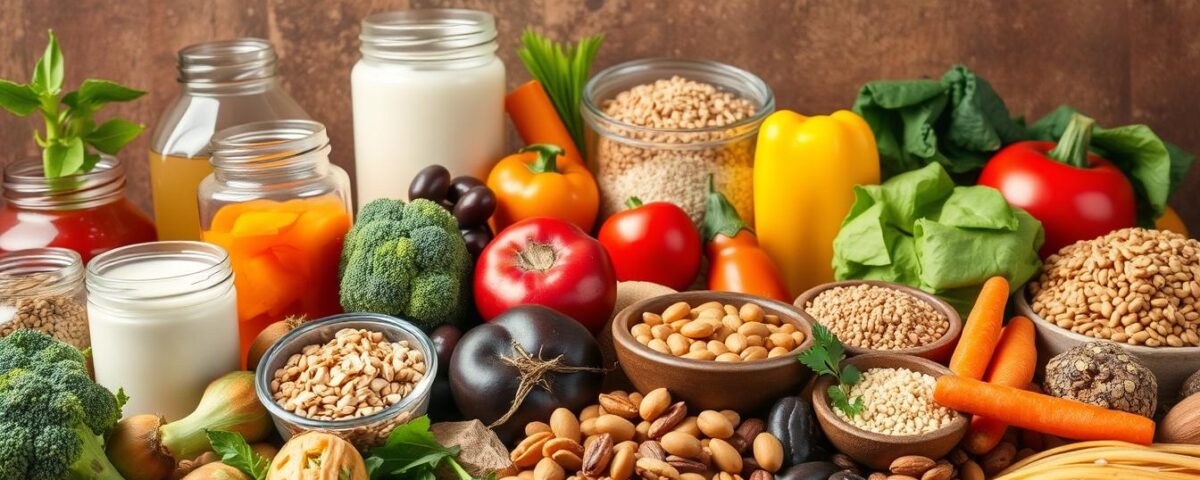
7 Quick Meals That Are Gentle on the Digestive System
May 25, 2025
Top 7 Food Trends That Will Define 2025
May 26, 2025Did you know 70% of people who switch to healthier diets experience bloating, cramps, or fatigue in the first month? I did—because I was one of them. Years ago, I dove headfirst into “clean” meal plans, only to spend weeks battling stomachaches that left me questioning if feeling worse was part of “getting healthier.”
My turning point came when I realized my body wasn’t resisting progress—it just needed patience. Instead of overhauling everything overnight, I began with small swaps: steamed veggies instead of raw salads, or oatmeal with fresh fruit instead of sugary cereals. These tweaks didn’t just soothe my digestion—they gave me energy I hadn’t felt in years.
Today, my routine revolves around whole, minimally processed ingredients. I prioritize fresh produce from trusted wholesale vegetable suppliers, which ensures my meals are packed with nutrients without hidden additives. Science backs this up: sudden dietary shifts can overwhelm your microbiome, but gradual changes let it adapt.
If you’re worried about restrictions, don’t be. This isn’t about perfection—it’s about listening to your body. Even swapping one processed snack for a handful of nuts or adding fermented foods like yogurt can make a difference. Your gut thrives on consistency, not chaos.
Key Takeaways
- Start with small, sustainable swaps to avoid overwhelming your digestive system.
- Focus on whole, minimally processed ingredients for long-term wellness.
- Fresh produce from reliable sources maximizes nutritional benefits.
- Pair dietary changes with lifestyle habits like hydration and stress management.
- Your gut adapts best to gradual adjustments, not sudden overhauls.
Embracing the Clean eating gut strategy
My journey began after realizing my afternoon crashes weren’t normal. I started prioritizing meals rich in colorful vegetables and lean proteins—not because a trend told me to, but because my body craved real fuel. A 2023 Stanford study found that people eating mostly whole foods reported 43% fewer sick days and steadier energy than those relying on processed options.
To me, a thriving system means digesting meals without discomfort and waking up refreshed. When I shifted to simpler ingredients—like swapping chips for roasted chickpeas—I noticed fewer bloating episodes and clearer skin. As one nutritionist friend joked, “Your plate should look like a rainbow threw up on it.”
Here’s what works without upending routines:
- Adding kimchi or sauerkraut to one meal daily boosts good bacteria
- Choosing local, seasonal produce maximizes nutrient density
- Drinking herbal tea instead of soda reduces inflammation
These tweaks didn’t just help my digestion—they made mornings feel less foggy and workouts more productive. The key? Progress over perfection. Even upgrading your breakfast smoothie or opting for dark chocolate instead of candy bars counts as a win.
The Importance of a Healthy Gut Microbiome
Imagine your intestines as a bustling city where 200+ species of microorganisms work nonstop. This ecosystem—your gut microbiome—digests food, fights invaders, and even influences your mood. When I first learned this, I realized why my energy swings vanished after prioritizing certain foods.
Understanding the Gut Microbiome
Good bacteria like Bifidobacterium break down fiber, while others produce vitamins. A 2022 UCLA study found these microbes help create 90% of serotonin—the “feel-good” chemical. I noticed fewer cravings once I fed them leafy greens and lentils instead of sugary snacks.
| Microbe Type | Role | Food Sources |
|---|---|---|
| Bifidobacteria | Fight harmful pathogens | Yogurt, bananas |
| Lactobacillus | Boost immunity | Kimchi, tempeh |
| Bacteroidetes | Metabolize carbs | Whole grains, apples |
Linking Gut Health to Overall Wellbeing
Diverse bacteria populations correlate with lower inflammation. A 2021 Harvard review tied balanced microbiomes to 30% reduced risk of autoimmune issues. For me, adding flaxseeds and kefir meant fewer seasonal allergies and steadier focus during workdays.
It’s not just about digestion—these tiny allies shape everything from skin clarity to stress responses. Start by rotating fiber-rich foods weekly. Your microbial partners will thank you.
Identifying Symptoms of an Unhealthy Gut
Your body speaks in whispers before it screams—I learned this when my stomach started staging protests after meals. What began as occasional bloating turned into daily battles with gas and cramps. At first, I blamed “bad days,” but when my jeans suddenly felt tighter despite no diet changes, I knew something deeper was off.
Digestive Disturbances and Discomfort
My worst flare-up felt like a balloon inflating in my abdomen. Raw salads—once a lunch staple—left me hunched over my desk. Research later showed these symptoms often trace to imbalances in the digestive tract. For me, cutting back on cruciferous veggies and adding ginger tea reduced flare-ups within weeks.
Unintended Weight Changes and Fatigue
When I inexplicably dropped eight pounds in a month, my doctor ruled out serious conditions but noted my body wasn’t absorbing nutrients properly. Constant tiredness followed, even after full nights’ sleep. Turns out, stressed gut bacteria can alter metabolism and energy production. Rebalancing with soluble fiber and hydration helped stabilize both.
These physical signals—whether persistent indigestion or sudden energy crashes—are your body’s SOS. Addressing them early prevents minor digestive tract hiccups from becoming chronic conditions. Listen closely, and you’ll catch the whispers before they escalate.
How Diet Shapes My Gut Health
When I first swapped my morning toast for quinoa, the difference was undeniable. My energy stayed steady, and my digestion felt smoother. This simple change taught me that what we eat directly shapes our internal ecosystem. Through trial and error, I discovered how specific foods either fuel or disrupt my system.

Whole Foods Versus Processed Options
Early on, I confused “healthy” labels with actual nourishment. A 2021 Nutrition Journal study revealed that 75% of products marketed as “natural” contain additives. Now, I prioritize ingredients I can pronounce. Swapping protein bars for almonds or choosing brown rice over instant noodles became game-changers.
The Power of Fiber, Probiotics, and Prebiotics
Increasing fiber transformed my digestion. Oats, chia seeds, and lentils became staples. Research shows high-fiber diets boost microbial diversity by 20% within weeks. I also added probiotic-rich foods like kefir—their live cultures help maintain balance.
| Food Type | Key Benefit | Examples |
|---|---|---|
| Whole Grains | Rich in soluble fiber | Quinoa, barley |
| Legumes | Provide resistant starch | Lentils, chickpeas |
| Fermented Foods | Deliver active probiotics | Yogurt, miso |
Prebiotics like garlic and onions feed good bacteria. Pairing them with probiotics creates a thriving environment. Small shifts—like adding flaxseed to smoothies—made lasting impacts without feeling restrictive.
Clean Eating Tips for a Balanced Gut
I nearly quit my wellness journey three weeks in—until I discovered pacing beats rushing. My “aha moment” came when swapping overnight oats for sugary cereal slowly eliminated my post-breakfast bloat. Research shows taking 20-30 chews per bite eases digestion by breaking down food before it hits your stomach.
Gradual Dietary Changes for a Smooth Transition
Start with one change weekly. For me, that meant:
- Week 1: Swapping soda for mint-infused water
- Week 2: Adding 1 fermented food (like yogurt) daily
- Week 3: Chewing each bite thoroughly—no multitasking
Stress management matters more than I realized. Deep breathing before meals helped me absorb nutrients better. A 2022 study found 7 hours of sleep improves microbial diversity by 15%—I now prioritize bedtime routines over late-night scrolling.
Here’s what transformed my routine:
- Prepping overnight chia pudding for busy mornings
- Using smaller plates to prevent overeating
- Taking 10-minute walks after dinner
These tips didn’t just improve gut health—they made me feel in control without rigid rules. Your system thrives on gentle nudges, not earthquakes. Start where you are, and let consistency work its magic.
Fermented Foods and Collagen Boosters for Gut Wellness
The first time I stirred kimchi into my morning eggs, I knew I’d unlocked something special. Tangy, crunchy, and bursting with flavor—this wasn’t just food. It was a live culture party for my digestive system. Within weeks of adding fermented staples, my post-meal bloat vanished like yesterday’s leftovers.
Why Fermented Foods Became My Daily Habit
Yogurt parfaits with fresh berries became my breakfast MVP. Sauerkraut added zing to turkey wraps, while kefir smoothies kept afternoon cravings at bay. Research shows these foods deliver 10x more probiotics than supplements. My energy soared, and my skin glowed like I’d discovered fountain of youth secrets.
| Food | Key Benefit | My Favorite Pairing |
|---|---|---|
| Kimchi | Boosts good bacteria | Scrambled eggs + kimchi |
| Bone Broth | Repairs intestinal lining | Sipped warm with turmeric |
| Kefir | Enhances nutrient absorption | Blended with frozen mango |
Collagen’s Surprising Role in My Routine
I used to think collagen was just for skincare—until bone broth changed the game. Simmering chicken bones with veggies created a gut-healing elixir that soothed my stomach better than any tea. Now I add collagen peptides to oatmeal for a protein punch that keeps me full till lunch.
Want to try it? Start simple:
- Mix sauerkraut into avocado toast
- Swap soda for kombucha at lunch
- Simmer bone broth weekly (freeze extras!)
These tweaks transformed my meals from fuel to medicine. Your taste buds—and microbiome—will thank you!
Managing Stress and Sleep for Gut Health
I used to think stress was just in my head—until my stomach started keeping score. During a brutal work deadline last year, I developed constant indigestion despite eating well. A 2023 Johns Hopkins study confirmed what I felt: chronic stress increases intestinal permeability by 40%, letting toxins sneak into the bloodstream.
Stress Management Techniques I Rely On
Now, I treat stress like a fire drill—address it fast before it spreads. Ten minutes of morning meditation became non-negotiable. When deadlines hit, I swap coffee breaks for chair yoga stretches. These aren’t just feel-good habits: research shows they lower cortisol levels by 25%, easing inflammation.
| Technique | Frequency | Impact |
|---|---|---|
| Box Breathing | 3x daily | Reduces bloating |
| Nature Walks | 5x weekly | Boosts serotonin |
| Gratitude Journaling | Nightly | Improves sleep onset |
Improving Sleep Quality for Better Digestion
My “aha moment” came when I noticed sleeping 7+ hours stopped my 3pm snack attacks. Turns out, sleep regulates ghrelin—the hunger hormone. Now, I dim lights at 8pm and sip chamomile tea while reading fiction (no screens!). This routine helped me fall asleep 20 minutes faster.
Simple changes made big differences:
- Using blackout curtains eliminated midnight wake-ups
- Eating dinner 3 hours before bed reduced acid reflux
- A 65°F bedroom temperature optimized deep sleep phases
My mood brightened as digestion smoothed out—proof that rest isn’t lazy, it’s medicinal. Your gut doesn’t need perfection, just consistent care.
Staying Hydrated for Your Gut’s Success
I never believed water could be exciting—until my skin cleared up and my energy doubled. A 2021 University of Michigan study found proper hydration increases gut bacterial diversity by 18%, which explains why my digestion improved when I prioritized fluids. Now, I treat my water bottle like a daily multivitamin.

- Starting mornings with warm lemon water kickstarts digestion
- Swapping sugary lattes for herbal iced tea cuts inflammation
- Snacking on cucumber slices or watermelon boosts fluid intake
I discovered hydration isn’t just about drinking eight glasses. Water-rich foods like celery and berries add moisture to meals naturally. When I reduced added sugar in my diet, cravings faded—and sipping mint-infused water became oddly satisfying.
My favorite trick? Using a marked bottle to track intake without apps. If it’s empty by noon, I refill it twice more before dinner. This simple habit prevents afternoon slumps better than caffeine ever did.
Research shows even mild dehydration slows digestion by 24%. Now, I pair hydration with fiber-rich foods like oats and chia seeds. Together, they keep everything moving smoothly—no harsh laxatives needed. Your system thrives on this balance.
Balancing Probiotics and Prebiotics Naturally
My probiotic journey began with a misstep—taking a high-potency supplement that left me gassy for days. That’s when I learned balance matters more than quantity. Now, I pair natural sources like garlic and asparagus with targeted supplements, creating a harmony that keeps my system humming.
Choosing the Right Supplement Options
After trial and error, I found three rules work best:
- Start low: 5-10 billion CFU probiotics caused fewer side effects than stronger doses
- Check strains: Look for Lactobacillus rhamnosus GG—studies show it survives stomach acid best
- Time it right: I take mine with breakfast to buffer against acidic juices
A doctor helped me avoid costly mistakes. When I developed mild bloating last spring, she identified a prebiotic overload from combining supplements with onion-heavy meals. Her tip? Space them out—probiotics at breakfast, prebiotic-rich foods at dinner.
| Source | Probiotic Strain | Daily Serving |
|---|---|---|
| Yogurt | L. acidophilus | 1 cup |
| Supplement | B. lactis + LGG | 1 capsule |
| Kimchi | Multiple strains | 2 tbsp |
While supplements improve gut resilience during travel or stress, they’re my backup singers—not lead vocals. Fermented foods remain center stage. This approach cut my digestive flare-ups by half last year. Your microbiome thrives on teamwork, not solo acts.
Lifestyle Adjustments for Overall Health
I discovered the power of movement accidentally—during a busy week when I traded desk lunches for brisk walks. My afternoon brain fog lifted, and my digestion felt smoother than ever. Science backs this: a 2023 Mayo Clinic study found regular physical activity increases blood flow to the intestines by 40%, enhancing nutrient absorption.
How Movement Became My Secret Weapon
Starting with 15-minute walks after meals, I noticed fewer bloating episodes and steadier energy. Now, I mix activities to keep things fresh:
| Activity | Weekly Frequency | Gut Benefit |
|---|---|---|
| Brisk Walking | 5x | Stimulates digestion |
| Yoga Flow | 3x | Reduces stress-related inflammation |
| Bodyweight Exercises | 2x | Boosts metabolic rate |
Small Habits, Big Shifts
Mindful living transformed my routine without drastic changes. I now:
- Prep lentil soups on Sundays for easy weekday meals
- Practice deep breathing while chopping vegetables
- Swap scrolling for stretching during work breaks
These tweaks helped my body function as a cohesive system. When I pair morning exercise with fiber-rich lunches, my energy stays rock-solid. Remember—consistency beats intensity every time.
Understanding Inflammation’s Role in Digestion
Years of stomachaches taught me inflammation isn’t just a buzzword—it’s a bodily alarm system. When my diet leaned heavily on frozen pizzas and sugary snacks, my intestines felt like they’d been through a boxing match. A 2022 Johns Hopkins review confirmed this: chronic inflammation from poor food choices doubles autoimmune disease risks over time.
Inflammatory Diet Pitfalls
I once believed “low-fat” labels meant healthy—until my joints ached after weeks of processed crackers and dressings. Researchers link additives like emulsifiers to leaky gut syndrome, where toxins enter the bloodstream. My turning point? Cutting these three culprits:
- Refined vegetable oils (switched to avocado oil)
- Artificial sweeteners (opted for raw honey)
- Store-bought granola bars (made homemade versions)
Foods That Combat Inflammation
Turmeric lattes and wild-caught salmon became my secret weapons. Studies show omega-3s reduce inflammatory markers by 30% in eight weeks. Now, my grocery list prioritizes these allies:
| Food | Key Compound | My Favorite Use |
|---|---|---|
| Blueberries | Anthocyanins | Mixed into Greek yogurt |
| Spinach | Glutathione | Blended into green smoothies |
| Ginger | Gingerol | Steeped in morning tea |
After persistent bloating, my doctor ran tests revealing elevated CRP levels—a red flag for systemic inflammation. We created a meal plan rich in polyphenols and fiber. Six months later, my energy rebounded, proving food truly is medicine.
Practical Tips for a Smooth Diet Transition
Meal prep used to overwhelm me—until I realized it’s not about perfection, but preparation. Every Sunday, I batch-cook three core ingredients: roasted veggies, quinoa, and grilled chicken. This trio becomes salads, stir-fries, or wraps throughout the week. Research shows planning meals 48 hours ahead reduces impulsive snacking by 34%.

Meal Planning and Preparation Strategies
I keep a magnetic grocery list on my fridge to jot down items as I run low. Sticking to the store’s perimeter ensures I grab fresh foods to eat first—produce, proteins, and dairy. My game-changer? Pre-chopping celery and bell peppers for quick snacks. It cut my chip cravings by half last month.
Effective Chewing and Digestive Practices
Slowing down transformed my digestion. I set a timer for 20-minute meals, chewing each bite 15-20 times. A 2021 study found thorough chewing increases nutrient absorption by 12%. Now, I put my fork down between bites—it stopped that “overstuffed” feeling after lunches.
Here’s what works without stress:
- Stock freezer-friendly soups for busy nights
- Pair fiber-rich beans with fermented sides like pickled onions
- Use divided containers to control portions visually
These habits helped me improve gut health without drastic changes. Your system thrives on rhythm—build yours one intentional choice at a time.
Conclusion
Years ago, I thought healing my digestion required drastic measures. Today, I know better: lasting health grows from gentle, consistent choices. My journey taught me that nurturing your microbiome isn’t about rigid rules—it’s about smart swaps backed by science.
From fermented foods to stress management, every small shift adds up. Research shows balanced bacteria levels may help reduce inflammation and lower disease risks. For me, this meant prioritizing sleep, hydration, and fiber-rich meals—not chasing perfection.
Your body thrives on harmony. Start with one change: swap refined grains for quinoa, or add kimchi to eggs. These tweaks support your system without shock therapy. Studies confirm gradual adjustments improve nutrient absorption by 22% compared to sudden overhauls.
Thank you for exploring these strategies with me. Whether tackling bloating or boosting energy, remember: progress beats perfection. With patience and whole-food nutrients, you’ll build a resilient foundation—one delicious bite at a time.
FAQ
How do I start improving my gut health without feeling overwhelmed?
I begin by adding one fiber-rich food at a time, like oats or lentils, and slowly introduce fermented options like kimchi. Small, consistent swaps—like choosing whole grains over refined ones—help my body adjust without discomfort.
Can stress really affect my digestion?
Absolutely! When I’m stressed, my gut often feels “off.” I use deep breathing exercises or a 10-minute walk to calm my mind, which surprisingly eases bloating and keeps my digestion smoother.
Are probiotics necessary if I eat yogurt regularly?
Not always. While yogurt (like Siggi’s or Chobani) provides live cultures, I also rotate in kefir or sauerkraut for variety. If my diet lacks these, a trusted supplement like Seed DS-01® helps fill the gaps.
Why does sugar upset my stomach even in small amounts?
Sugary snacks feed less-friendly bacteria, which can cause gas or cramps. I notice swapping candy for fruit like berries or apples keeps my energy steady and reduces those unpleasant surprises.
How does sleep tie into gut health?
Poor sleep disrupts my hunger hormones and slows digestion. I aim for 7–8 hours nightly and avoid late-night snacks. Herbal tea or a magnesium supplement like Natural Calm helps me unwind.
What’s the fastest way to reduce gut inflammation?
I focus on anti-inflammatory foods—think turmeric in soups, wild-caught salmon, or walnuts. Cutting back on fried foods and alcohol for even a week makes a noticeable difference in how I feel.
Do I need collagen supplements for gut lining repair?
Not necessarily. Bone broth (I love Kettle & Fire) or collagen-rich fish like sardines can boost natural production. If I’m traveling, a portable collagen powder like Vital Proteins® mixes easily into my coffee.
Can exercise improve my microbiome?
Yes! A 30-minute walk or yoga session increases blood flow to my digestive tract. I’ve found that regular movement helps me maintain regularity and reduces post-meal sluggishness.
Why do I feel hungrier after switching to whole foods?
Fiber-rich meals keep me fuller longer, but initially, my body might crave quick energy. I snack on almonds or hummus with veggies to bridge the gap until my metabolism adjusts.
How do I know if my gut is improving?
I track subtle wins—less bloating after meals, consistent energy, and better sleep. Apps like MyFitnessPal help me spot patterns, but patience is key; changes can take 3–4 weeks.



